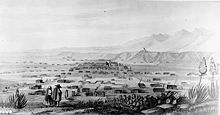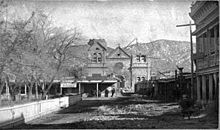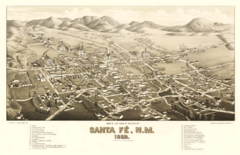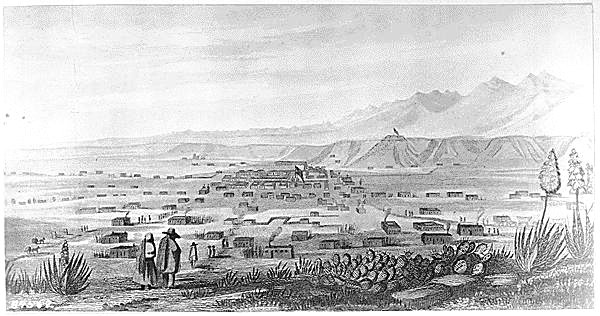Santa Fe settlers are “churlish types” who are “accustomed to live apart from each other, as neither fathers nor sons associate with each other.” — Governor Fermín de Mendinueta, c. 1776

The city of Santa Fe was originally occupied by a number of Pueblo Indian villages with founding dates between 1050 to 1150. One of the earliest known settlements in what today is downtown Santa Fe came sometime after 900. A Native American group built a cluster of homes that centered around the site of today’s Plaza and spread for half a mile to the south and west; the village was called Ogapoge. The Santa Fe River provided water to people living there. The Santa Fe River is a seasonal waterway which was a year round stream until the 1700s. As of 2007, the river was recognized as the most endangered river in the United States, according to the conservation group American Rivers.
Don Juan de Oñate led the first effort to colonize the region in 1598, establishing Santa Fé de Nuevo México as a province of New Spain. Under Juan de Oñate and his son, the capital of the province was the settlement of San Juan de los Caballeros north of Santa Fe near modern Ohkay Owingeh Pueblo. New Mexico’s second Spanish governor, Don Pedro de Peralta, however, founded a new city at the foot of the Sangre de Cristo Mountains in 1610, which he called La Villa Real de la Santa Fé de San Francisco de Asís, the Royal Town of the Holy Faith of Saint Francis of Assisi. In 1610, he made it the capital of the province, which it has almost constantly remained, making it the oldest capital city in what is the modern United States. (Jamestown, Virginia, is of similar vintage (1607) but is no longer a capital.) Santa Fe is at least the third oldest surviving American city founded by European colonists, behind the oldest St. Augustine, Florida (1565). (Although Santa Fe is not one of the oldest continuously occupied cities, as from 1680–1692 it was abandoned due to Indian raids. A few settlements were founded prior to St. Augustine but all failed, including the original Pensacola colony in West Florida, founded by Tristán de Luna y Arellano in 1559, with the area abandoned in 1561 due to hurricanes, famine and warring tribes. Fort Caroline, founded by the French in 1564 in what is today Jacksonville, Florida only lasted a year before being obliterated by the Spanish in 1565.)
Except for the years 1680–1692, when, as a result of the Pueblo Revolt, the native Pueblo people drove the Spaniards out of the area known as New Mexico, later to be reconquered by Don Diego de Vargas, Santa Fe remained Spain’s provincial seat until the outbreak of the Mexican War of Independence in 1810. In 1824 the city’s status as the capital of the Mexican territory of Santa Fé de Nuevo México was formalized in the 1824 Constitution.
United States

The Republic of Texas had claimed Santa Fe as part of the western portion of Texas along the Rio Grande when it seceded from Mexico in 1836. In 1841, a small military and trading expedition set out from Austin, Texas, with the aim of gaining control over the Santa Fe Trail. Known as the Santa Fe Expedition the force was poorly prepared and was easily captured by the Mexican army. In 1846, the United States declared war on Mexico, and Brigadier General Stephen W. Kearny led the main body of his Army of the West of some 1,700 soldiers into the city to claim it and the whole New Mexico Territory for the United States. By 1848 the U.S. officially gained New Mexico through the Treaty of Guadalupe Hidalgo.
Colonel Alexander William Doniphan under the command of Kearny recovered ammunition from Santa Fe labeled “Spain 1776” showing both the quality of communication and military support New Mexico received under Mexican rule.
American visitors saw little promise in the remote town. One traveller in 1849 wrote:
“I can hardly imagine how Santa Fe is supported. The country around it is barren. At the North stands a snow-capped mountain while the valley in which the town is situated is drab and sandy. The streets are narrow… A Mexican will walk about town all day to sell a bundle of grass worth about a dime. They are the poorest looking people I ever saw. They subsist principally on mutton, onions and red pepper.” — letter from an American traveler, 1849

In 1851, Jean Baptiste Lamy arrived; in 1853 he became bishop of New Mexico, Arizona, Utah, and Colorado and traveled to France, Rome, Tucson, Los Angeles, St. Louis, New Orleans and Mexico City. He built Saint Francis Cathedral and shaped Catholicism in the region until his death in 1888.
For a few days in March 1862, the Confederate flag of General Henry Sibley flew over Santa Fe, until he was defeated by Union troops.
On October 21, 1887, “The Padre of Isleta”, Anton Docher went to New Mexico where he was ordained as a priest in the St Francis Cathedral of Santa Fe by Bishop Jean-Baptiste Salpointe. After a few years spent in Santa Fe, Bernalillo and in Taos, he arrived in Isleta on December 28, 1891. He wrote an interesting ethnological article published in The Santa Fé Magazine on June,1913, in which he describes the early 20th century’s life in the Pueblos.

Santa Fe was originally envisioned as an important stop on the Atchison, Topeka and Santa Fe Railway. But as the tracks progressed into New Mexico, the civil engineers decided that it was more practical to go through Lamy, a town in Santa Fe County to the south of Santa Fe. A branch line was completed from Lamy to Santa Fe in 1880 and the Denver and Rio Grande Western Railroad extended the narrow gauge Chili Line from the nearby city of Espanola to Santa Fe in 1886, but the result of bypassing Santa Fe was a gradual economic decline. This was reversed in part through the creation of a number of resources for the arts and archaeology, notably the School of American Research, created in 1907 under the leadership of the prominent archaeologist Edgar Lee Hewett. The first airplane to fly over Santa Fe was piloted by Rose Dugan, carrying Vera von Blumenthal as passenger. Together they started the development of the Pueblo Indian pottery industry, a major contribution to the founding of the annual Santa Fe Indian Market.
In 1912, New Mexico became the United States of America’s 47th state, with Santa Fe as its capital.

